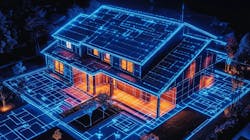Matter: A More Efficient Future for Smart Homes and EV Connectivity
What you’ll learn:
- How Matter 1.4 improves compatibility and interoperability among smart-home devices and enables seamless communication and integration within smart-home ecosystems.
- Why Matter 1.4 is the foundation that will create intelligent automation, where environmental settings within the home will be tailored to the individual needs of occupants.
- The impact of Matter 1.4’s new energy-management and monitoring support.
Matter isn’t just delivering on interoperability across a growing range of smart-home devices. It’s also making homes more efficient and energy-aware, as well as revolutionizing in-home electric-vehicle (EV) charging as an extension to the home environment.
We live in a highly connected world, with countless brands and even more smart devices aiming to make our lives easier at every step. If companies want to make the smart home an everyday reality, however, there needs to be widespread compatibility and interoperability between devices. This is also true when it comes to the vehicles we rely on every day, and Matter’s interoperability offers the potential to shape how EV technology is further incorporated into daily life.
The Need for Greater Compatibility
As more and more devices hit the smart-home and IoT markets, it’s no longer feasible for devices to exist within their own bubble. In the past, consumers often bought into a specific brand, a particular protocol, or a single type of connectivity, which is restrictive when it comes to adding new devices.
This limitation also makes for a poor user experience. It’s far too easy to buy a device and discover that it doesn’t work as expected, or it experiences problems in the future. For homes to become truly smart, safer, and more efficient, devices must communicate directly with each other, regardless of brand.
Matter introduces interoperability across the smart home and IoT market so that devices from different brands and different smart-home platforms work with each other out of the box. Thanks to Matter, devices from tech giants such as Amazon, Apple, Google, and Samsung SmartThings, along with products from hundreds of other manufacturers and smart-home ecosystems, can communicate with each other seamlessly.
This is just the start. For companies such as NXP, which have played a key role not only in shaping Matter but the Connectivity Standards Alliance (originally Zigbee Alliance) itself, as well as being involved in the smart-home industry for more than two decades, the vision is to transform the smart home. The aim is to support autonomous homes capable of intelligently adapting to occupants and conditions within or outside of the home.
Autonomy Through Awareness and Intelligent Learning
Greater interoperability makes it easier to implement environmental settings preferences, helping occupants to benefit from increased comfort and security. At present, though, smart homes generally involve different apps to implement functionality, along with manually setting up automation and links between devices that would otherwise be unaware of each other.
The smart-home industry is driving toward an environment or a home network that learns from the behaviors of occupants in each type of environment. Consumers want technology that can learn and intelligently manage preferences and tailor settings to individual needs throughout the house.
>>Check out this TechXchange for similar articles and videos
The autonomous home needs Matter as a foundation for that level of interoperability, creating the basis for such intelligent automation. Through Matter, smart devices in the home are able to all discover, connect, and communicate with each other. As a result, they can leverage much richer and broader information about the environments they’re operating in, along with enhanced capabilities as devices work together. Experiences can then be personalized to the individuals in these home environments through innovative new technologies such as UWB (ultrawideband)-enabled smartphones or tags, which support recognition of who and where the individual is in the home.
In other words, this intelligence, used with data from Matter-connected sensors throughout the home combined with newly introduced occupancy detection and ambient sensing features in Matter 1.4, are able to recognize movement and even intent. They can share that information with other smart devices to open doors or change environmental settings as each individual moves throughout the house. This could include opening and closing blinds, changing the temperature, or turning on lights, the TV, music, and more, based on learned preferences.
More Device Types, Features, Energy Management, and Reduced Carbon Footprints
The latest versions of Matter support a host of new device types and capabilities (see figure), introducing support for additional appliance device types such as microwave ovens, ovens, cooktops, extractor hoods, and laundry dryers. There’s further support for energy-related device types like solar power, battery storage, heat pumps, water heaters, EV charging, and enhancements to thermostats. Water-management capabilities, such as water valves and flow sensors, have also been introduced, aligning water and energy resource management under the same interoperability framework.
Matter’s new energy-management and monitoring support may have the biggest impact, though. Energy-management features help to make the smart home more efficient. For each device, homeowners can receive detailed, real-time energy data, such as instantaneous power usage, forecasted energy needs, and cumulative energy consumption or sourcing.
These new energy reporting capabilities, along with newly introduced device energy-management features that enable devices to pause, resume, or adjust energy usage levels depending on home energy needs, will help consumers make more informed decisions. More importantly, they will also enable Matter-based energy-management systems to intelligently and autonomously manage energy usage throughout the home on a real-time basis.
Energy costs, along with managing usage between critical and flexible or interruptible loads based on dynamic pricing throughout the day, are key considerations when it comes to managing energy efficiently. Alternative energy sources, including battery storage devices or even EVs, are also capable of powering homes, either intermittently or exclusively. Grid limitations in various regions require load management, too.
For energy management to be successful, it’s necessary to have everything connected locally so that devices can discover and be aware of each other. This is where Matter’s interoperability is crucial.
Electric-Vehicle Charging Support
The latest iterations of Matter also introduce functionality that extends to EVs, further driving energy efficiency and control across the home. Matter provides support for electric-vehicle supply equipment (EVSE), which includes consumer-friendly ways to control how and when homeowners and occupants charge their vehicles at home.
The technology features the ability to manually start or stop charging and adjust the charging rate. It also supports the creation of user-defined preferences, such as specifying how many miles of range need to be added by a set departure time. This leaves the charging station to automatically optimize the charging to happen at the cheapest and lowest carbon times based on energy pricing, availability and real-time household energy usage for load balancing needs. These enhancements to EVSE provide the foundations for the seamless integration of EVs into the smart-home ecosystem.
Interoperability with EV charging technologies is a newer challenge with only a limited number of existing protocols to provide this connectivity and awareness between home, energy control devices, and EVSE. It’s also still at a point where no single technology or standard supports all use cases. Thus, Matter is in a great place to help steer the industry by ultimately connecting vehicles to the smart home in a standardized way.
Again, this is just a starting point, with the potential to support connected vehicles in the future. Matter’s greater interoperability and intelligence also introduce the possibility for vehicle-to-grid (V2G) charging and two-way charging capabilities. Being able to communicate with technology in the home is critical in this instance, with the potential for vehicles to supply electricity back to the grid or even supply the home. Here’s where Matter’s energy-management controls and monitoring can make a key difference.
Knowing exactly where the car is located, the journeys planned, or even the time a homeowner or occupant generally leaves home means the smart home can make better-informed decisions on when to charge a car. Not only does this make sure there’s enough battery power to reach the destination, but it can also ensure the lowest cost energy at a level that’s conducive to other loads within the home.
The Complexities of Interoperability
Of course, all of this isn’t easy. It’s never the case with wireless technology and having reliable connectivity. Along with needing to support a significant number of brands, devices, and industries, Matter must support a broad range of use cases when it comes to connectivity, which requires using different protocols, including Wi-Fi, Thread, and Bluetooth.
This is where companies within the Connectivity Standards Alliance, such as NXP, can provide invaluable experience and solutions that reduce complexity so that manufacturers are able to focus on innovation. NXP provides a collection of Matter solutions to address the growing range of device types, from sensors to gateways, including Thread Border Routers and Bridges, to other existing protocols like Zigbee.
The company’s portfolio of processors and connectivity and security solutions and services helps device manufacturers accelerate development and deployment of Matter devices. This includes NXP’s Matter-certified development platforms, which integrate advanced intelligent processing, security, and connectivity into flexible system solutions, such as single-chip solutions that address the protocols and capabilities needed for Matter and application use cases.
Seamlessly Connecting Our Lives
As the pace of smart-home adoption quickens, communication and compatibility between devices and platforms globally will become increasingly more important, with Matter ensuring every area of our lives can be connected as seamlessly as possible. The latest Matter enhancements in energy management, occupancy detection, and EV integration represent the building blocks for an energy-intelligent future. These capabilities aren’t just “nice to have”—they’re “must haves” and play a vital role in the future of sustainability and resource efficiency.
>>Check out this TechXchange for similar articles and videos
About the Author
Sujata Neidig
Director of Marketing for Wireless Connectivity in IoT, NXP Semiconductors
Sujata Neidig has over 30 years of experience in the semiconductor industry, serving in a variety of roles ranging from product engineering to marketing and business development. She is currently the Director of Marketing for Wireless Connectivity in IoT. She also leads NXP’s standards efforts for IoT connectivity, represents NXP on the Thread Group and Connectivity Standards Alliance’s Board of Directors, and serves as Thread Group’s VP of Marketing. Sujata has a degree in electrical engineering from the University of Texas at Austin.
Neal Kondel
Product Marketing for Smart Home Wireless Connectivity Solutions, NXP Semiconductors
Neal Kondel has over 25 years of experience in the software and semiconductor industries, including product management, marketing, and engineering, with a focus on various fields such as wireless IoT, security, and power management. Neal currently leads NXP’s connected ecosystems as the director of wireless connectivity solutions. He also helps drive NXP’s standards efforts, including serving on the Connectivity Standards Alliance’s Board of Directors. He holds undergraduate and graduate degrees in electrical engineering and business administration.


